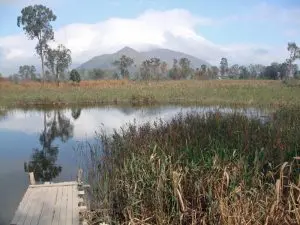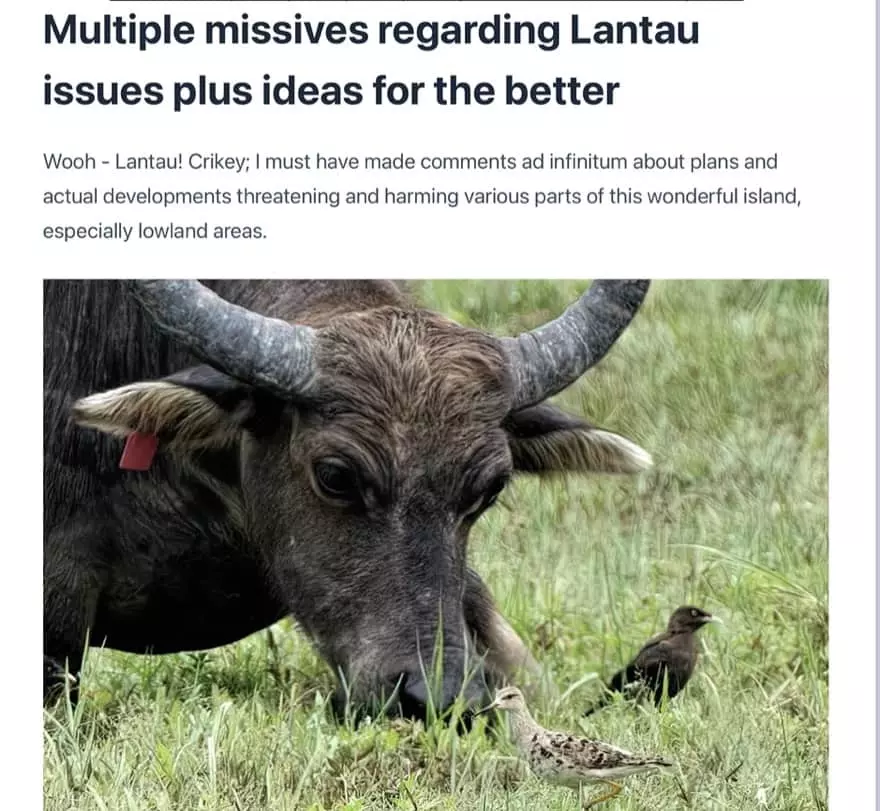Visit Sai Wan on a hot sunny Sunday, and it can seem like the type of tropical “paradise” that many seek, yet few find. In this bay on the eastern Sai Kung Peninsula, tens of people unwind on beaches and frolic in clear azure waters. Some hiked to get here; others arrived on cruisers moored beyond the shallows. There are islets on the eastern horizon, lush green headlands to north and south; and these plus a hillside inland help make the area seem akin to a lost world, remote from the city.
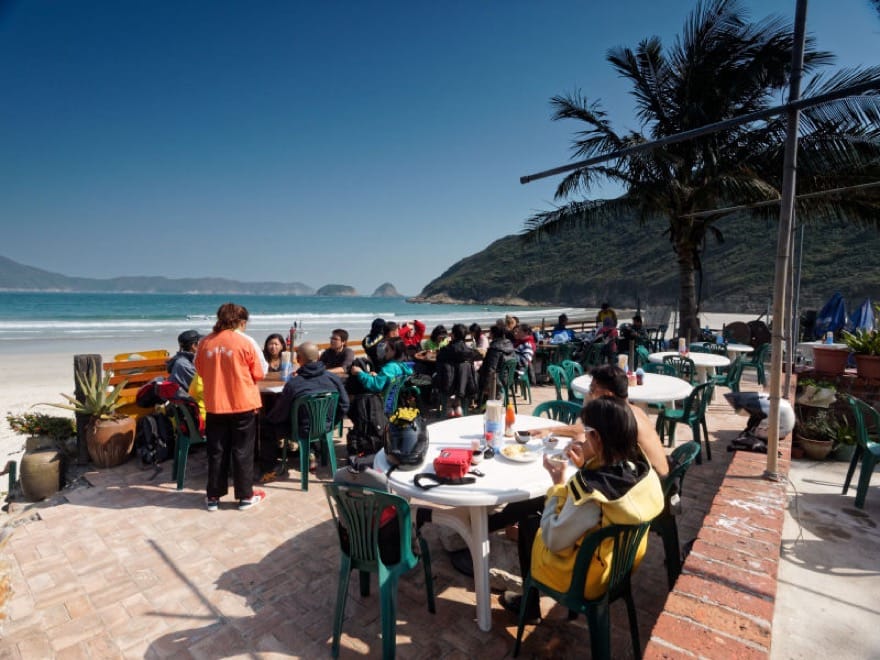
Restaurants in the Sai Wan hamlet are busy. Two have tables where diners can admire one of the greatest views in Hong Kong.
Yet Sai Wan is far from being paradise. [Written for the South China Morning Post in 2014, but situation not much changed since I believe.]
I knew this even before I arrived one recent weekday, and my impression that turmoil swirled around Sai Wan was confirmed on being introduced to beachfront restaurant owner Lai Kwan. Told I was writing this feature, Kwan at first refused to speak with me, as he’s so disgusted with both the Post’s coverage of the Sai Wan situation, and the government’s attempts to enforce rules that have severely impacted and still threaten his business.
Thanks to friends who patiently explained I wanted to tell Kwan’s side of the story, he did open up, relating his tale plus a little history. It’s a tale that has implications way beyond Sai Wan, as until recently this was one of over 70 country park “enclaves” – areas within and yet technically excluded from country parks. Thanks to planned and actual developments at enclaves including Sai Wan, there is considerable concern and controversy over their status, and how best to protect them.
Kwan’s tale is complex, yet is only a small part of the remarkably convoluted story of these enclaves – which involves quirky policies, rapacious developers, green groups alarmed by their schemes, crusty rural leaders, villagers baffled by byzantine regulations. And, looming large, there’s a government bereft of vision and sorely lacking a human touch.
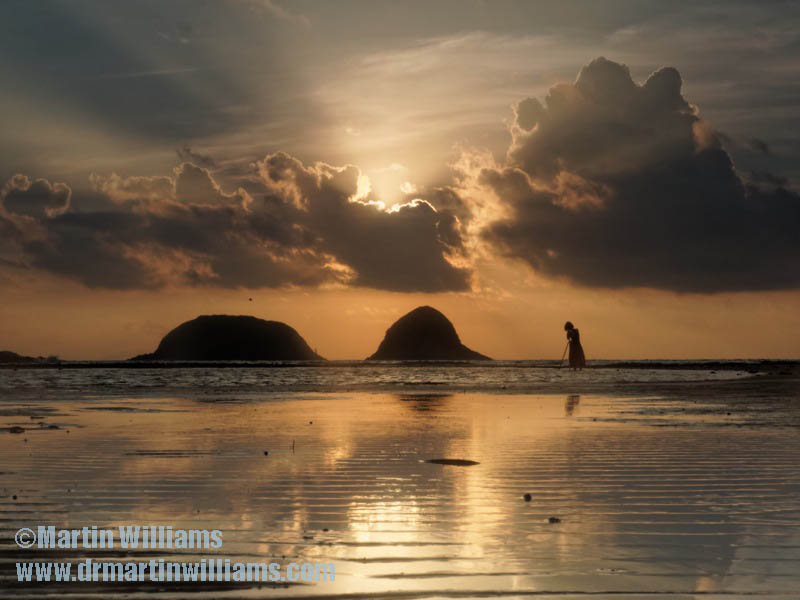
Country park enclaves problem grew into a monster
The enclaves’ story began in the 1970s, when the country parks were first established under governor Sir Murray Maclehose. “There was a great deal of opposition amongst villagers,” recalls Sir David Akers-Jones, a key architect of the country park system. “ If we hadn’t had enclaves, we wouldn’t have country parks. We overcame the problem of villages by drawing a line a line around them. All the land surrounding them became part of the country parks. And that succeeded.”
At the time, there were many more rural people in villages than nowadays, but Akers-Jones says city people didn’t think of living in the countryside. Yet the seeds of future troubles were already sown.
In 1972 – four years before the country parks system was established – the government had introduced a measure to help these rural people: the small house policy. It was intended to be temporary, and would “allow an indigenous villager to apply for permission to erect for himself during his lifetime a small house on a suitable site within his own village.” But over the years since, many small houses have been built for renting or selling to outsiders, generating profits, whilst resulting in Hong Kong’s peculiar rural sprawl – with jumbles of Spanish villas spreading through and around many villages.
“I knew straight away the policy would be problem,” says Akers-Jones. “It has turned into something quite different from what was intended, and grown into a monster.”
The “monster” was given space to grow as Hong Kong farming rapidly declined. Even in the 1970s, there was something of an exodus from the rural New Territories, prompted partly by fields drying as water was diverted to reservoirs. The exodus accelerated, with many people heading overseas.
Rather as nature abhors a vacuum, idle land in Hong Kong attracts opportunists. Readily accessible village areas were transformed by Spanish villas. “For hundreds of years, village houses were restrained according to customs,” says Akers-Jones. “If someone needed a house, and village people agreed, it was done in an orderly way. But that became forgotten about.”
In more remote places, there was no such housing boom. But they did not go unnoticed by developers large and small, which bought land rights from villagers who might have lived overseas for years, and devised schemes to make money.
During the early 1990s, several green groups cooperated to argue against plans for a golf course plus luxury housing at Shalotung, near Tai Po Market. The plans were rejected, and some angry villagers bashed down vegetation with bulldozers. In 1995, the appearance of a bulldozer at Ham Tin – in Tai Long Wan, just north of Sai Wan – likewise led to a joint green group objection, and the government introducing strict planning controls.
While Shalotung and Ham Tin featured prominently in local news, some nefarious activities occurred out of the public eye. Sun Hung Kai was evidently behind large scale destruction of former paddyfields that had become a wonderful wetland at Sham Chung, east of Ma On Shan. Plans for a golf course and resort stalled, and the destruction has so far been for nothing.
Public outcry over intended development at Sai Wan
With something of a free-for-all in the enclaves, Simon Lo Lin-shing must have thought he was on to a good thing when he bought a strip of land at Sai Wan. Lo, chairman of Mongolia Energy Corporation, perhaps aimed for a golf course. But in July 2010, after a hiker reported excavators clearing land of vegetation, there was a public outcry.
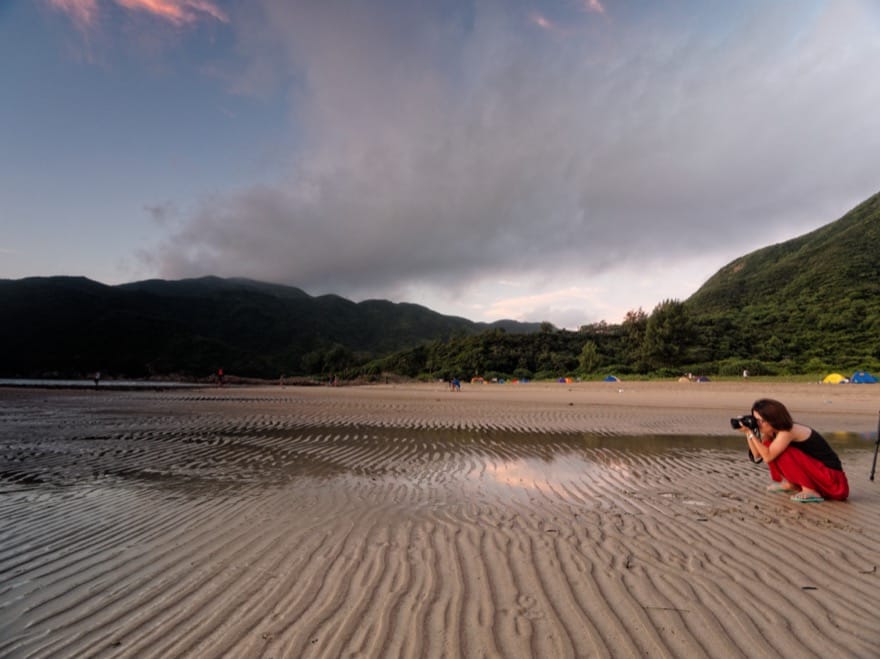
Within days, over 40,000 people joined a Facebook group calling for protection of Sai Wan. Most work was halted. A draft development permission area plan was introduced. During his policy address that October, Chief Executive Donald Tsang said, “the recent Tai Long Sai Wan incident has highlighted the need to take prompt action to regulate land use in the vicinity of country parks to forestall human damage.” There were now statutory plans for four enclaves, but another 50 sites adjacent to country parks – ie, enclaves – were unprotected, and the government would either include them into country parks, or determine their proper uses by statutory planning.
Environmentalists like Paul Zimmerman, founder and CEO of Designing Hong Kong, hoped the “Sai Wan incident” would prove a turning point in the ongoing battle to safeguard enclaves. He oversaw the establishment of Save Our Country Parks, a loose alliance of groups concerned about the countryside. “The enclaves are deep inside country parks,” he says. “If we allow development, the spill over of human activity will be enormous – with construction, more fire risk, sewage entering nearby waters, risk of poaching, and light pollution.”
Of the two ways the government can protect enclaves – through the Town Planning Ordinance, and inclusion in country parks, Zimmerman favours the latter as, “The Town Planning Board can’t stop eco vandalism: there’s no management, and no patrols.” Though assessments are supposedly ongoing, he believes that in 2010 the government decided how to divvy up the pie, by including a few smaller enclaves like Sai Wan in the country park system, with the Town Planning Board responsible for the others – even though its remit does not include managing land zoned for nature conservation.
The reason, says Zimmerman, is that making enclaves part of the country parks would mean too much hard work, and the Agriculture, Fisheries and Conservation Department (AFCD) lacks resources. “I think individually, every person in the AFCD wants to do a good job,” he says. “But I’m very disappointed with some of their senior management, like director Alan Wong, and assistant directors Joseph Sham, and Leung Siu-fai, and even more so with people like Elvis Au, assistant director of the Environmental Protection Department. They continue to fail to stand up to the Heung Yee Kuk and the development bureau. Their job is to protect the environment, not to promote development interests.”
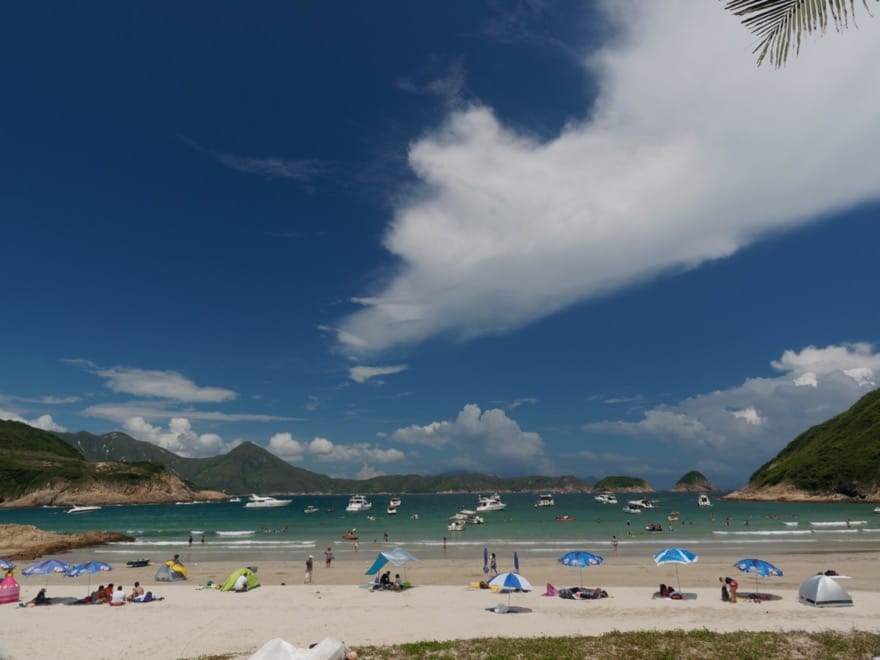
WWF Hong Kong is among the main proponents of protecting enclaves, and Michael Lau, Senior Head of Programme, Local Biodiversity and Regional Wetlands explains, “These are not just typical holes in country parks. They have special habitats, with streams and rivers, and abandoned fields that turn into freshwater marshes. They are under represented in country park system, which tends to protect hilly areas, so have plants and other species that rare or absent in country parks.”
Lau mentions that with their Hakka villages, the enclaves also host a wealth of culture and history. “I think if the enclaves are planned very well, working closely with villagers, we can keep their cultural, recreational, and ecological value,” he says. “All bodies involved should sit down, and decide what we would like to see in 30 to 50 years time.”
But as a report from WWF Hong Kong indicates, the pressures on enclaves are mounting. The report cites a little known yet “shocking” case of woodland and marsh destruction at Lo Shue Tin, set within Ma On Shan Country Park. Land lots here had been bought by a developer, and the destruction – which came to light late last year – was surely a prelude to building houses for non-villagers. Like the Sai Wan incident and several other cases, the situation at Lo Shue Tin was exposed by a hiker, rather than the AFCD.
There are also applications for substantial increases in village housing in enclaves such as at the remote and largely ruined hamlet of So Lo Pun in the northeast New Territories, and Hoi Ha, beside a marine park supporting a wealth of hard coral species. Both were among six enclaves which, earlier this year, the AFCD refused to include in country parks.
Judicial reviews, and situation not black and white
Debby Chan, project manager of Designing Hong Kong and de facto secretary of Save Our Country Parks, was so outraged by the decision that she sought a judicial review against it. “The AFCD is responsible for protecting the Country Parks,” she wrote in an email. “Why is it that we can’t trust them? Why are they not ‘fighting’ to protect the parks they are responsible for? I do not accept that they are willing to risk the destruction of our natural heritage.”
In contrast, a judicial review against incorporating Sai Wan in country park was sought by villager Thomas Lai, supported by the Heung Yee Kuk. Though rejected in February, the application added to impressions that the Heung Yee Kuk opposes conservation. This in turn makes it tempting to portray enclaves as places where green groups battle the Kuk. Yet talk to people in the Heung Yee Kuk, and you find the true picture is not so straightforward.
“Obviously urban people treasure tranquil areas, and would very much like to preserve status quo,” says Junius Ho, chairman of Tuen Mun Rural Committee. “But to villagers, there are better uses of land than keeping it idle, and if they have private property that’s never been included in country parks, they should be allowed to build.” Ho notes that many applications have been rejected for the last 10 years, and there’s an unhappy relationship between the government and villagers.
“The government has two faces,” he adds. “To village representatives, they say there’s nothing to stop you building houses. But applications could be stopped, particularly if there’s a rare species of insect, or a green area. Somebody has to depressurise the situation.”
While supporting villagers’ rights, Ho considers, “Profiteering has to be stopped. There has been no revision to the small house policy since it was introduction in 1972, so loopholes cannot be plugged. I think the scheme should be overhauled, which will take courage, and commitment.”
Joseph Mo is a member of the Heung Yee Kuk’s committee on country parks and convenor of a working group on Sai Wan. He says that as the country park system was launched, “The government promised a lot to villagers, who would gain some economic benefit. For example, they would be allowed to set up restaurants, and sell food and drink to hikers. Private land would be a buffer they could grow into. Donald Tsang changed the policy, by saying there would be planning control over the enclaves, without looking at their history.”
Mo agrees with green groups that there shouldn’t be major developments in country parks. “There should be a balance,” he says. “I want to grow villages into living history; some have been there for 700 or 800 years. I want the government to help them, so people can live happily in villages.”
Lam Chiu-ying, former director of the Hong Kong Observatory and co-founder of the Hong Kong Countryside Foundation, is overseeing a project with just such aims, at Lai Chi Wo in the northeast New Territories. “HKCF is cooperating with University of Hong Kong, Produce Green Foundation, the Conservancy Association and Lai Chi Wo villagers in an agriculture-led village re-vitalisation project,” he explained by email. Along with working fields again, former residents will be encouraged to return to the village, and there will be guided educational tours.
“My vision is that Lai Chi Wo would become again a living village where indigenous villagers once again feel proud of their villagers, and could make enough money from nature-friendly local economic activities,” added Lam.
Hong Kong Chief Executive Leung Chun-ying was another founder of the Hong Kong Countryside Foundation. Lam thought he genuinely appreciated the joy which hills and countryside brought to people, but considers that since becoming chief executive Leung has been surrounded by pro-“development” people, and trapped by his own promise to solve the housing problem.
For this story, I emailed questions to CY Leung. There was no reply, though I did receive written replies to questions emailed to AFCD director Alan Wong, and environment secretary Wong Kam-sing. Sadly, these were couched in bureaucratese, and evaded several questions.
Alan Wong avoided commenting on an earlier remarks quoted in the media, about not being able to just fold any piece of land into country parks based on high ecological value – as if this was the case, we’d have to fold Shek O or the Peak into parks, too – and claiming the AFCD’s decisions regarding enclaves must be trusted on the basis of their professional expertise (prior to joining the AFCD, Wong was commissioner for transport). He did, however, note that, “The AFCD attaches great importance to the conservation of natural environment and biodiversity.”
Rather than answer whether he was surprised at the anger in Sai Wan, after it was incorporated in country park, Wong Kam-shing mentioned a management plan which has the support of the Country and Marine Parks Board.
Walking into Sai Wan, I pass a metal fence that villagers erected once Sai Wan was included in country park last December, blocking entry to outsiders. I notice no evidence the village is now in country park, and wonder why work on the management plan only began early this year.
A difficult situation for small restaurants
I meet Dave Wilson, director of Surf Hong Kong Limited, which operates a surf school in Sai Wan. He has seen local restaurants suffer lately, as officials arrived to implement rules, including a group of 20 men who hacked down a rain and sun shelter along with toilets at Lai Kwan’s place. “The government walked and rode roughshod over them,” he says. “It’s just bizarre. Kwan’s place was clean, comfortable, welcoming; it was built with his own sweat and tears.”
Wilson believes the government should instead help villagers, such as with interest-free loans so they can make changes needed to obtain licences, but instead they tell them that it will be almost impossible for them to get a licence, implying they shouldn’t even try.
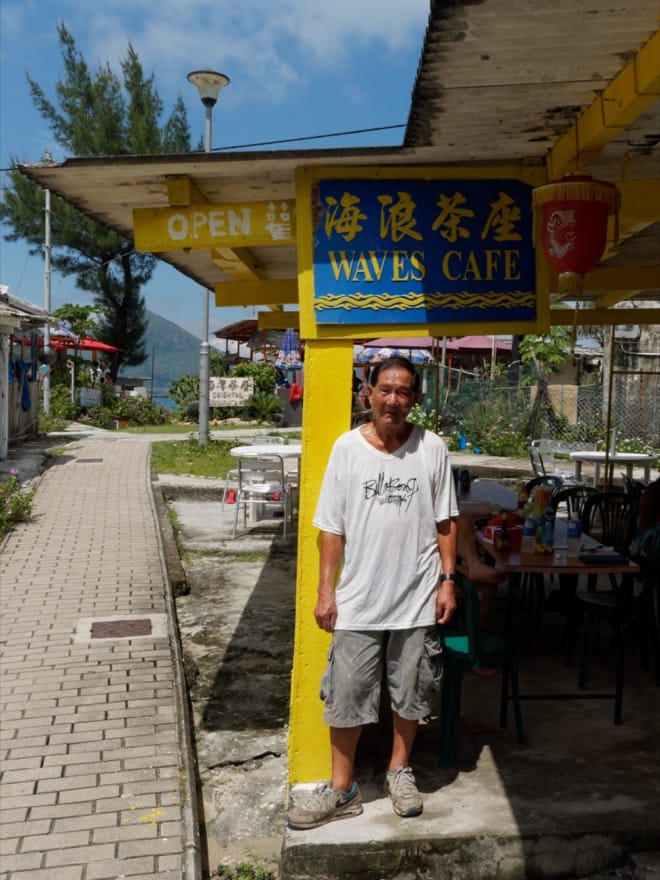
David Lai Mau runs a small restaurant opposite the surf school. He was among villagers who left for the UK, working in restaurants there from around 1961 to 1978, before returning home as he believed Hong Kong had changed for the better. He had operated the restaurant for well over 30 years with no one from the government either troubling or helping him. But with Sai Wan entering the country park, officials keep bothering him about the need for a restaurant licence.
“I’m not clear what to do,” says Lai. “I feel very sad, it’s a very difficult situation.”
At his nearby Oriental Restaurant, Kwan says the village was established around 400 years ago, and he is the third generation of his family to operate a restaurant on this site. Sixty years ago, the area was more populous, and there was a storage area for fishermen, which his grandfather turned into a simple restaurant.
Kwan’s father then took over the restaurant. After he fell ill, Kwan came home following 20 years as a restaurant cook in the UK, and in turn began operating the restaurant. Licensing only became an issue around seven years ago, when officials checked hygiene. Though given a clean bill of health, Kwan made changes to meet licensing regulations like installing a stainless steel ventilation system, yet with officials nervous about the country park, the licence has so far proven elusive.
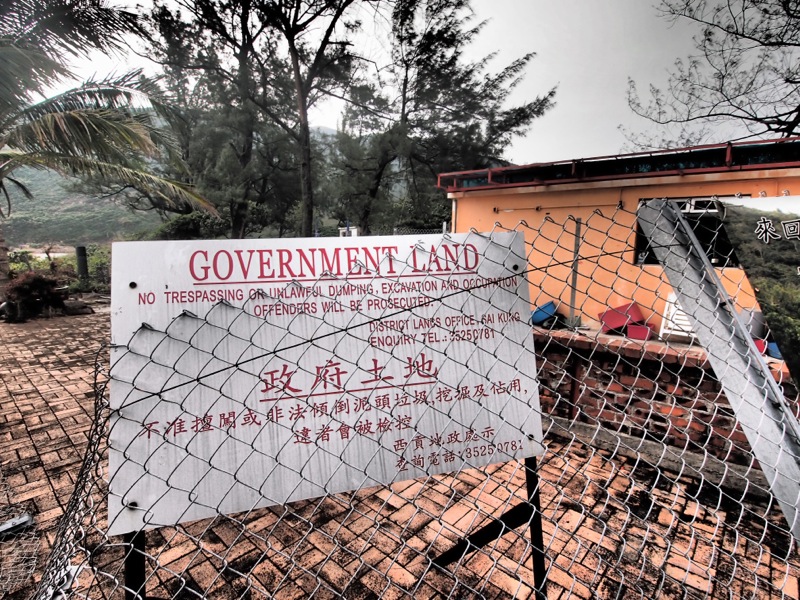
Plus, Kwan has been told he cannot use a neighbouring patch of government land where he built a seating area overlooking the beach. “I put a lot of effort in, and made it beautiful. Everybody liked it. So why can’t I use it?” he asks. One solution might be rental for a nominal fee, which he asked the AFCD working committee about, but so far no one has said yes.
Now, Kwan says officials hassle him almost every day. He has been told to remove a table from outside his restaurant, or face a fine. Licences are now required for having bicycles. People can no longer camp on the beach. Barbecues aren’t allowed. A partially disabled villager was fined for having a small electric vehicle.
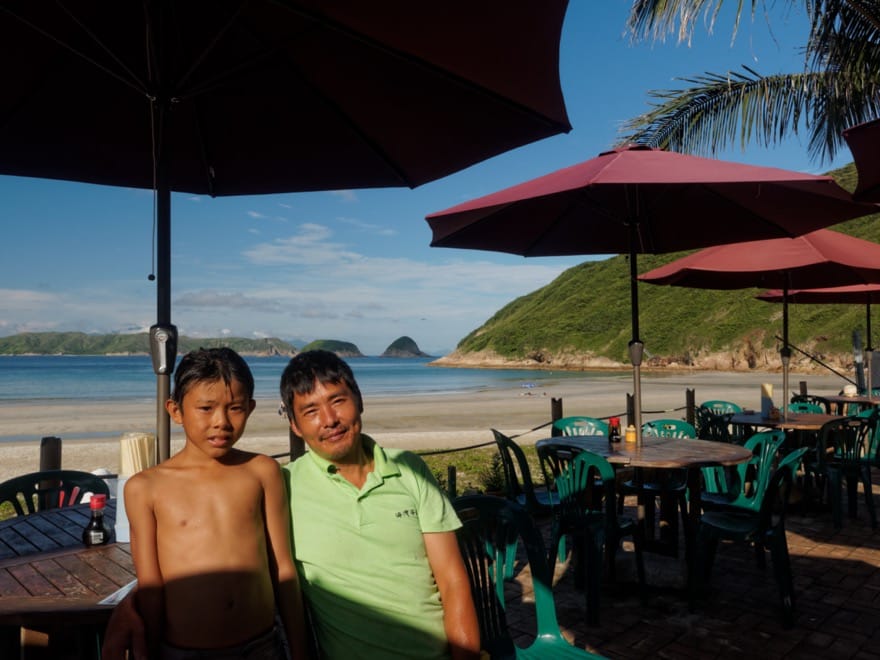
“The government claimed there would be a lot of good changes after Sai Wan became country park,” says Kwan. “But we villagers can’t see them. Nothing is better after becoming country park.”




